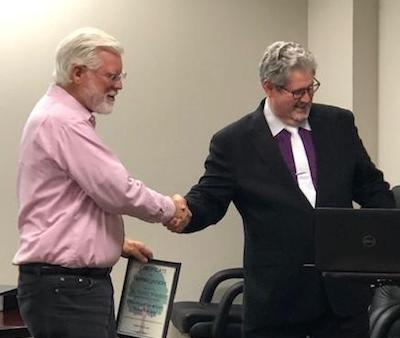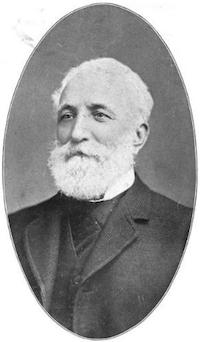
February 20, 2023 - If it hadn't been for the railroad, there probably wouldn't have been a meeting of the Timpson Area Genealogical and Heritage Society last Wednesday and it certainly wouldn't have been on Bremond Street in a town named Timpson. Speaking to TAGHS, SFA History Professor Dr. Scott Sosebee shared the profound impact the railroad had on East Texas and the man who first brought rails through Shelby County, Paul Bremond.
“Cities are organic, living things, and they grow, or don't grow, for a lot of different reasons, but one of the most important is transportation. Those places that prospered and thrived not only had access to transportation conduits, they made sure that whatever means existed for the channeling of people and goods to their town remained up-to-date,” Sosebee began. “There are many examples of places that grew or died as the result of transportation, but few are more dramatic than Nauvoo, Illinois. You probably have never heard of Nauvoo. It's in west central Illinois, on the Mississippi River. In the mid-1800s, Nauvoo was a bustling port city with a population of 20,000 people, which made it one of the largest cities in Illinois at the time. The leaders of Nauvoo were so confident that the river was the key to their continued prosperity that they neither sought nor encouraged railroads to come to their town. The smaller city of Chicago to their north did just the opposite, seeking out every railroad they could for service to their city. As a result, Chicago is now the third largest city in the United States and Nauvoo has dwindled to a current population of about 750,” Sosebee revealed.
“In an example closer to home, when the Republic of Texas was established in 1836, San Antonio was its largest city. The second largest city in Texas was Nacogdoches. Nacogdoches was located at the intersection of El Camino Real and Trammel's Trace, essentially the only land routes into and out of Texas in those days. About the same time a settlement was founded about 100 miles south of Nacogdoches in what some described as a 'malarial swamp,'” Sosebee continued. However, by the 1870s, Nacogdoches' population had shrunk to less than 200 people and the town had been eclipsed by surrounding cities like Henderson. The primary reason for Nacogdoches' decline was the lack of rail service. However, the settlement 100 miles to the south, Houston, had a population of over 9000, was linked to New Orleans by rail, and was becoming a port of entry to Texas. It is now the fourth largest city in America.”
 “Of course, Nacogdoches didn't die, but, ironically, it was saved by Houston, and the efforts of a quirky person named Paul Bremond,” said Sosebee. “Bremond had been a successful businessman from the northeast but relocated to Texas after he lost most of his wealth in the Panic of 1837. He prospered in Houston and created a grandiose plan for a railroad network linking Houston with other major cities. His first railroad was established in 1855 and became the Houston and Texas Central, eventually linking Houston with Dallas and Sherman to the north.”
“Of course, Nacogdoches didn't die, but, ironically, it was saved by Houston, and the efforts of a quirky person named Paul Bremond,” said Sosebee. “Bremond had been a successful businessman from the northeast but relocated to Texas after he lost most of his wealth in the Panic of 1837. He prospered in Houston and created a grandiose plan for a railroad network linking Houston with other major cities. His first railroad was established in 1855 and became the Houston and Texas Central, eventually linking Houston with Dallas and Sherman to the north.”
“I said Bremond was a little quirky. Although he had been reared an Episcopalian, he began to call himself a “Spiritualist” as an adult,” Sosebee said. “One of his most ardent beliefs as a Spiritualist was in re-incarnation. He believed that a spirit from a previous life guided people in their present life by speaking to them. Bremond believed that his spirit guide was Mosley Baker, an early Texan who had fought at the Battle of San Jacinto, served in the Texas Legislature, and died in 1848. Bremond told others that Baker had come to him and told him that he needed to build another railroad, this time one which connected Houston to Shreveport. Bremond followed through and this new railroad was chartered by the State of Texas as the Houston East and West Texas Railway in 1875. His ultimate goal was to expand the railroad into west Texas and provide transportation for shipping cattle to markets in the north.”

“Bremond assembled a group of investors and construction of the H.E.W.T. began with a huge ceremony in downtown Houston on July 4, 1876 which featured Gov. Richard Coke. However, despite the investors and Bremond pouring almost his entire fortune into the new railroad, it was still under-capitalized. Although the State of Texas had provisions for granting lands for the construction of railroads, these state-owned lands were mostly in west Texas, not east Texas where the H.E.W.T. was being built. As a result, the new railroad had to buy all the necessary right-of-way, which was very expensive. Construction of the railroad through the forests of east Texas was also expensive, since the right-of-way had to be cleared before the track could be laid. As a result, Bremond made a serious mistake,” Sosebee shared. In an effort to save money, Bremond chose to build a narrow gauge railway instead of a standard gauge. While this did reduce the initial cost, it limited the ability of the H.E.W.T to connect with other railway systems, since standard gauge rail cars can't run on narrow gauge tracks.”
“Construction progressed slowly. Although it had begun in July of 1876, the railway had reached only 20 miles north of the city by 1877 and didn't reach Livingston until 1879. Finally, in 1882 the railway established a “line-stop” in Angelina County and named it Lufkin. The line reached Nacogdoches in May of 1883. Timpson, named for an H.E.W.T. engineer, was established by the railway in 1885 and Tenaha in 1886. The line finally crossed the Sabine into Louisiana later that year and eventually on to Shreveport,” Sosebee said. “Unfortunately, Paul Bremond would not live to see the completion of the railway he had envisioned. He died in 1885 in Galveston.”
“Bremond's will was convoluted and took 20 years to settle. The H.E.W.T. went into receivership and, despite its grandiose name, never reached west Texas. The Union Trust Company of New York bought the company in 1892 and extended the line into west Texas and up to Kansas City. The new company exhausted most of their capital converting the H.E.W.T. From narrow gauge to standard gauge rails and was acquired by the Southern Pacific Railroad in 1899, although it continued to operate as the H.E.W.T. In the late 1920s the H.E.W.T. merged with the Texas and New Orleans Railway, also part of Southern Pacific,” continued Sosebee.
“Although it was tagged with some derisive nicknames such as “Hell Either Way Taken” and “The Rabbit” by passengers, the Houston East and West Texas Railway did pierce the “Pine Curtain” and open up east Texas, and that is historically significant”, Sosebee stated. “As I mentioned, Nacogdoches was saved by the H.E.W.T. When the railroad reached Nacogdoches in 1883 the city had a population of about 200. Withing just two years the city had grown to over 3000 people. That is phenomenal! Without the railroad, Nacogdoches would probably have withered away. The city's population remained about the same until 1923, when it was saved again by the founding of Stephen F. Austin State Teachers College.”
“The outer world would probably never heard of the H.E.W.T. had it not been for native son Tex Ritter, one of the pioneers of country music and probably the inventor of the 'singing cowboy'. Ritter remembered riding the H.E.W.T. in his youth and how the conductors would yell 'Tenaha, Timpson, Bobo, and Blair' as the train approached the station. Dice shooters also recalled the conductors' cry and adopted it for use when they wanted to throw a double five. Ritter wrote a popular song “Tenaha, Timpson, Bobo, and Blair” about it, whose lyrics are:
On the HE--WT line,
Old East Texas sure looks fine
Drop me off just anywhere (near)
Tenaha, Timpson, Bobo, and Blair
Here those drivers pound the rails,
Takin' me back to Texas trails,
Bought my ticket, paid my fair,
Tenaha, Timpson, Bobo, and Blair
Whooooo, waiting for the whistle,
Whooooo, when you hear the whistle,
It means that the stations not so far,
From where we are,
Let'er highball, engineer,
Pull that throttle, track is clear,
There's a gal just waitin' there,
Tenaha, Timpson, Bobo, and Blair.
The Timpson Area Genealogical Society meets at 2PM on the third Wednesday of each month in the meeting room of the Timpson Public Library on the corner of Austin and Bremond Streets in downtown Timpson. The TAGHS library is located within the Timpson Public Library and is open and staffed from 9AM until 5PM weekdays. Telephone 936-254-2966 and ask for the Genealogical Library.









